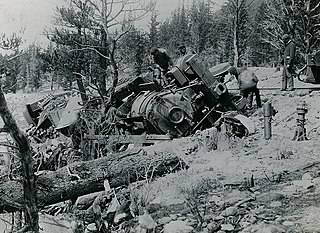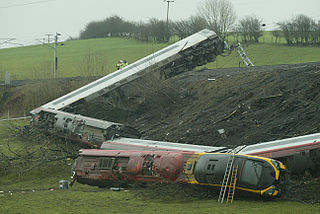
The Granville rail disaster occurred on Tuesday 18 January 1977 at Granville, a western suburb of Sydney, New South Wales, Australia, when a crowded commuter train derailed, running into the supports of a road bridge that collapsed onto two of the train's passenger carriages. The official inquiry found the primary cause of the crash to be poor fastening of the track.

Rail transport is a means of transport using wheeled vehicles running in tracks, which usually consist of two parallel steel rails. Rail transport is one of the two primary means of land transport, next to road transport. It is used for about 8% of passenger and freight transport globally, thanks to its energy efficiency and potentially high speed.

On 3 June 1998, an ICE 1 train on the Hannover-Hamburg railway near Eschede in Lower Saxony, Germany derailed and crashed into an overpass that crossed the railroad, which then collapsed onto the train. 101 people were killed and at least 88 were injured, making it the second-deadliest railway disaster in German history after the 1939 Genthin rail disaster, and the world's worst ever high-speed rail disaster.
Rail transport terms are a form of technical terminology applied to railways. Although many terms are uniform across different nations and companies, they are by no means universal, with differences often originating from parallel development of rail transport systems in different parts of the world, and in the national origins of the engineers and managers who built the inaugural rail infrastructure. An example is the term railroad, used in North America, and railway, generally used in English-speaking countries outside North America and by the International Union of Railways. In English-speaking countries outside the United Kingdom, a mixture of US and UK terms may exist.

The Quintinshill rail disaster was a multi-train rail crash which occurred on 22 May 1915 outside the Quintinshill signal box near Gretna Green in Dumfriesshire, Scotland. It resulted in the deaths of over 200 people and remains the worst rail disaster in British history.

There have been four railway accidents at Potters Bar (England). Those in 1898 and 1946 were signals passed at danger. The accident in 2002 led to substantial public debate and a national change in policy relating to maintenance of infrastructure.

The Hatfield rail crash was a railway accident on 17 October 2000, at Hatfield, Hertfordshire. It was caused by a metal fatigue-induced derailment, killing four people and injuring more than 70.

In rail transport, a derailment occurs when a rail vehicle such as a train comes off its rails. Although many derailments are minor, all result in temporary disruption of the proper operation of the railway system and they are a potentially serious hazard.
The Cowan rail accident occurred at 7:20pm on 6 May 1990 when the 3801 Limited special steam passenger train returning from the Morpeth Jazz Festival was struck in the rear by the following CityRail inter-urban passenger service. The steam train had stalled while attempting to climb the steep gradient from the Hawkesbury River to Cowan, New South Wales, and it was found that sand applied to the rails to regain traction had interfered with the signals and given the following train a false clear indication.

The Great Western Railway Leo Class2-4-0 was a class of broad gauge steam locomotives for goods train work. This class was introduced into service between January 1841 and July 1842, and withdrawn between September 1864 and June 1874.

The Shipton-on-Cherwell train crash was a major disaster which occurred on the Great Western Railway. It involved the derailment of a long passenger train at Shipton-on-Cherwell, near Kidlington, Oxfordshire, England, on Christmas Eve, 24 December 1874, and was one of the worst disasters on the Great Western Railway.

On the evening of 4 December 1957, two trains crashed in dense fog on the South Eastern Main Line near Lewisham in south-east London, causing the deaths of 90 people and injuring 173. An electric train to Hayes had stopped at a signal under the bridge, and the following steam train to Ramsgate crashed into it, destroying a carriage and causing the bridge to collapse onto the steam train. The bridge had to be completely removed; it was over a week before the lines under the bridge were reopened, and another month before the bridge was rebuilt and traffic allowed over it.


Slippery rail, or low railhead adhesion, is a condition of railways (railroads) where contamination of the railhead reduces the traction between the wheel and the rail. This can lead to wheelslip when the train is taking power, and wheelslide when the train is braking. One common cause of contamination is fallen leaves that adhere to the railhead of railway tracks. The condition results in significant reduction in friction between train wheels and rails, and in extreme cases can render the track temporarily unusable. In Britain, the situation is colloquially referred to as "leaves on the line".

The Grayrigg derailment was a fatal railway accident that occurred at approximately 20:15 GMT on 23 February 2007, just to the south of Grayrigg, Cumbria, in the North West England region of the United Kingdom. The accident investigation concluded that the derailment was caused by a faulty set of points on the Down Main running line, controlled from Lambrigg ground frame. The scheduled inspection on 18 February 2007 had not taken place and the faults had gone undetected.

The Sonning Cutting railway accident occurred during the early hours of 24 December 1841 in the Sonning Cutting through Sonning Hill, near Reading, Berkshire. A Great Western Railway (GWR) luggage train travelling from London Paddington to Bristol Temple Meads station entered Sonning Cutting. The train was made up of the broad-gauge locomotive Hecla, a tender, three third-class passenger carriages, and some heavily laden goods waggons. The passenger carriages were between the tender and the goods waggons.

The Kerang train accident occurred on 5 June 2007 at about 13:40 AEST in the Australian state of Victoria, approximately 6 kilometres (3.7 mi) north of the town of Kerang in the state's northwest, and 257 kilometres (160 mi) north-northwest of the city of Melbourne.

The Rockport train wreck occurred in Rockport in Mansfield Township, New Jersey, United States, about three miles outside of Hackettstown, on June 16, 1925. A violent storm washed debris onto a grade crossing, derailing a Lackawanna Railroad (DL&W) train. The crash killed 42 passengers and five crewmen and injured twenty-three others.

The Corning train wreck was a railway accident that occurred at 5.21 a.m. on July 4, 1912, on the Delaware, Lackawanna and Western Railroad at East Corning freight station in Gibson three miles east of Corning in New York State, leaving 39 dead and 88 injured.
Paul Knapman DL was Her Majesty's coroner for Westminster, from 1980 to 2011. His responsibility for investigating sudden deaths as an independent judicial officer saw him preside over numerous notable cases.

















